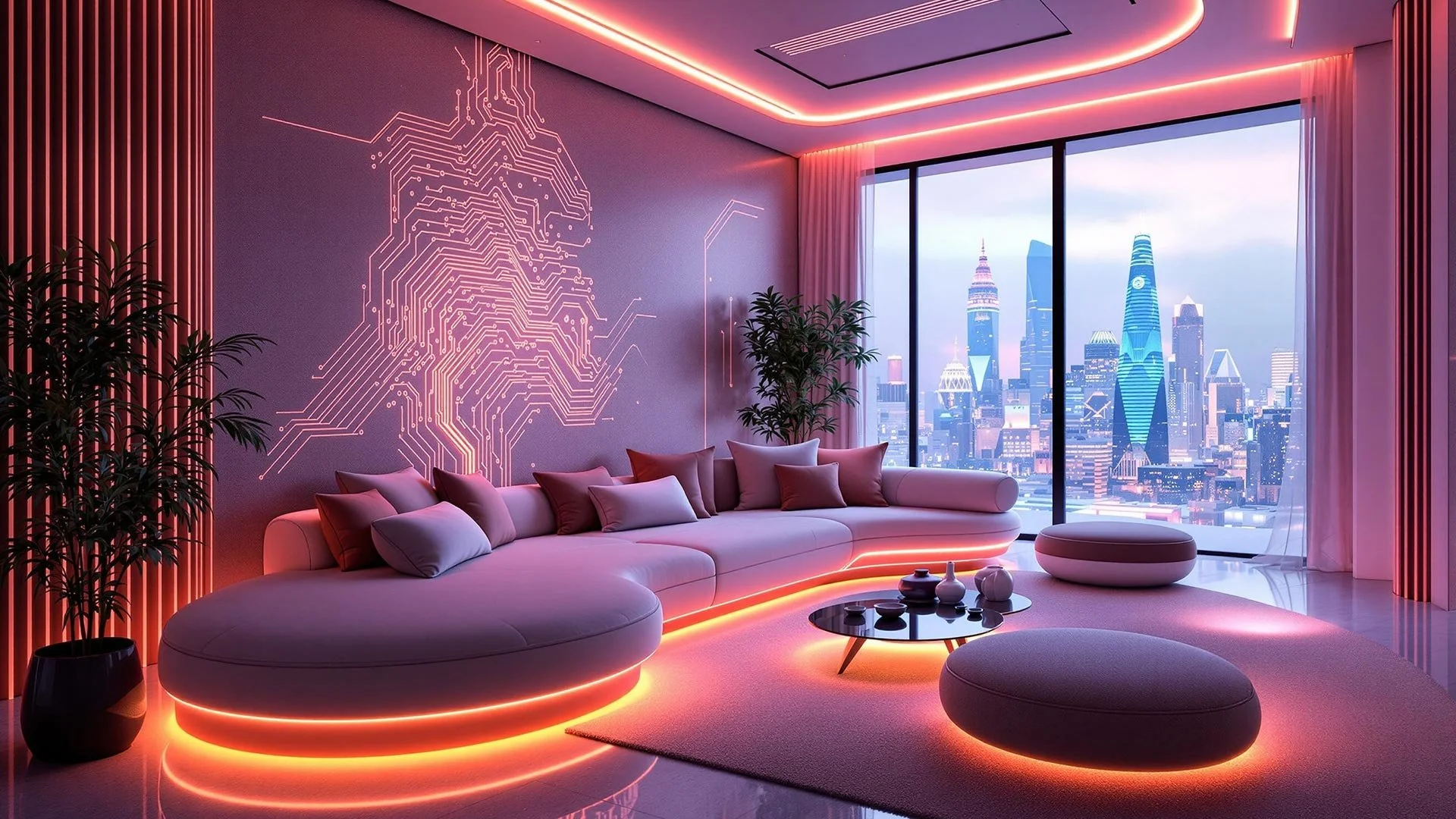Smart home automation: simple ways to upgrade your living space
Smart home automation brings everyday devices online so they can work together, learn your routines, and quietly handle jobs like lighting, heating, and security. In the UK, the draw is simple. Less faff. Lower bills. More comfort. The best systems feel invisible until you need them, then respond in seconds.
Smart home automation means connecting lights, heating, plugs, cameras, and more to a hub or app so they can be controlled remotely and set to run themselves. Start small with bulbs and plugs, add a thermostat, then layer in security and routines. Pick a platform you trust and build from there.
What Smart Home Automation Means Today In The UK
Across the UK, connected living has become normal rather than novel. Around four in ten households now use at least one smart device, with adoption heading toward one in two homes within a couple of years as prices fall and features mature [3]. The market is sizable as well, estimated at roughly £3.1 billion in 2025, which tracks with the shift from gadgets to dependable home infrastructure [1].
What changed. Three forces moved smart homes from gimmick to practical. First, energy costs pushed people to look for savings they can feel, not just read about on labels. Second, voice assistants and better apps removed friction, so tapping a button or asking for warm floors feels normal. Third, the Matter standard started smoothing compatibility headaches, which means devices can finally speak the same language across brands [5].
What people actually use. Smart speakers remain the on-ramp, but thermostats and security kits have grown fastest in UK homes, thanks to clear value and mobile alerts that actually help day to day [3]. AI now shapes routines in the background, like nudging heating schedules after a week of colder mornings or flagging a camera that repeatedly triggers on tree shadows so you can adjust sensitivity [4]. A modest promise stands out here. Smart tech should remove small hassles so you feel calmer at home, not more distracted.
How Smart Home Automation Works Hubs Apps And Assistants
Smart homes have three moving parts that work in concert. The hub or controller gives the orders. The network carries those orders. The devices do the work. You can run everything from a phone app, a voice-enabled speaker, or a dedicated hub that talks locally to your kit.
What a hub does and when a phone app is enough
A hub ties different brands and radios together so scenes and rules run even when the internet drops. Many homes do just fine with a phone-led setup at first. If most devices are Wi‑Fi based and “Matter-ready,” the phone and a smart speaker can cover schedules, scenes, and voice control. Move to a dedicated hub when any of the following happens. You want automations to run locally for reliability. You add many sensors that use Zigbee, Z‑Wave, or Thread. Or you want deeper logic and dashboards, which platforms like Home Assistant and SmartThings handle with ease [functions-HA, editor-verified].
Voice control with Google Assistant, Alexa and Siri
Voice is the most human interface when hands are full or you’ve just walked in with the shopping. Alexa and Google Assistant still lead for breadth of device support and multi-room audio, while Apple’s Siri via HomeKit shines for privacy and secure local control where available [functions-competitor, editor-verified]. The practical test is simple. Can you say “Goodnight” and have the hall lights dim, front door lock, heating set back, and cameras arm. If not, your setup isn’t finished yet.
Networks and protocols in plain English
Wi‑Fi. Great for cameras, doorbells, and thermostats that need bandwidth. Can crowd your router if every bulb is Wi‑Fi.
Thread. A modern, low-power mesh that’s fast and self-healing. It is increasingly used by Matter devices.
Zigbee and Z‑Wave. Reliable low-power meshes used by sensors and switches for years. Still excellent, especially in larger homes.
Bluetooth. Handy for direct setups and presence detection, not ideal for whole-home control.
Matter sits on top as a common language so devices join a platform without fiddly workarounds. The upshot. You can buy on features, not logos, and expect basic interoperability to hold [5].
Start Simple Smart Lighting Plugs Speakers And Sensors
A good smart home starts with quick wins. Swap a bulb, add a plug, try a motion sensor. In one afternoon, you can create tangible comfort without rewiring a thing. Most people start in the hallway and living room and end up wondering why the kettle isn’t smart too.
Quick wins you can install in an afternoon
Smart bulbs and dimmers. Fit Matter-capable bulbs for schedules and scenes. Use dimmers where you want physical control and family-proof reliability.
Smart plugs. Put floor lamps, dehumidifiers, and heated blankets on timers and energy monitoring. The better models show real power draw so you can spot energy hogs.
Motion sensors. Create soft hallway lighting after dark or a “lights on” trigger when someone steps into the utility room.
Speakers and displays. Use an Echo, Nest Hub, or HomePod mini as your daily control surface. Voice, plus a glanceable screen for timers, recipes, and camera feeds.
Small story, big payoff. Picture this. It’s 6.30 am on a winter weekday. The landing glows softly as you walk past. The kitchen radio starts. The kettle clicks via a smart plug. No taps, no phone. Just a home that anticipates the morning and feels a touch warmer than the weather deserves.
Smart kitchen ideas for the master chef at home
Kitchen automations work best when they cut faff and reduce mistakes. Use a smart display to set hands-free multiple timers. Add smart lighting scenes for “prep,” “dinner,” and “late tea” that change brightness and colour temperature. A smart plug can power the slow cooker at lunchtime and switch off by 2 pm. If you love coffee, schedule the machine preheat a few minutes before the alarm so the first cup is ready without a wait [functions-pcmag roundup, editor-verified].
Set routines for music timers and wake up lights
Build day anchors that run on their own. Create a weekday “Wake” routine that fades lights up over 10 minutes, nudges the thermostat, reads headlines, and starts a playlist quietly. Even small routines reduce decision fatigue and keep mornings consistent, which helps families run on time. At night, a single “bedtime” phrase can dim everything, arm cameras, and lower the heating for sleep.
Heat Comfort And Energy Smart Thermostats For UK Homes
Heating is where smart home automation pays for itself in the UK. Central heating schedules are often blunt. A smart thermostat adds presence, weather awareness, and finer control so comfort improves while consumption drops. As of 2025, common models combine app control, learning schedules, and open-window detection, with geofencing as the quiet hero feature [3][2].
Zonal heating schedules and geofencing basics
Zoning separates rooms into controlled areas. Add smart radiator valves in bedrooms and living spaces so heat goes where it’s needed. Pair that with geofencing and the system knows when the last person leaves, so it sets back automatically. When someone heads home, preheat starts so the house feels right on arrival. It’s unflashy, but this pattern saves money without a hint of sacrifice [2].
Cut energy use without feeling the cold
Lower setpoints slightly. A one-degree reduction trims usage while most people barely notice, especially with timed boosts for showers and evenings.
Use schedules aligned to routines. Targeted morning and evening warmth beats all-day background heating.
Lean on data. Many thermostats show weekly usage so you can spot waste and tweak by room rather than guessing [3].
Forecasts suggest AI-driven HVAC control can cut energy use by around a fifth by the late 2020s, driven by better pattern learning and weather responses. Treat that as an ambition, with household results varying by insulation and boiler type [2].
Which models work with common UK boilers
Most UK combi and system boilers play nicely with mainstream smart thermostats and smart TRVs. Popular picks include Hive Active Heating and Tado, known for UK-centric features like hot water control and geofencing. Always check your boiler’s control interface and whether you need a professional to fit a receiver near the boiler spur. Where in doubt, choose vendors with proven UK support and clear wiring guides [functions-device roundups, editor-verified].
Security You Can See Cameras Locks And Video Doorbells
Security products rank high because they change how a home feels. Clear video. Fewer false alerts. Doors that lock themselves. Good systems balance visibility with privacy and neighbourly manners.
Place a security camera without annoying neighbours
Angle cameras to watch your door, garden, and entry points, not the entire street. Keep zones tight so motion alerts don’t trigger on pavement traffic. Mount at head height where possible for better faces and fewer sky-driven glare events. A respectful install earns fewer complaints and yields better footage.
Create alerts that reduce false alarms
Use activity zones and person detection. Ignore trees and pets, focus on paths and gates.
Schedule quiet hours. Night alerts should be rare and meaningful.
Link devices. A door sensor opening can trigger a short camera clip and porch light scene so context is clear.
Some newer systems also enable 3D motion mapping or radar-like detection, which helps filter shadows and headlights that used to spam phones at dusk [functions-roundups, editor-verified].
Privacy friendly settings you should enable
Turn on end-to-end encryption when supported for indoor cameras.
Use two-factor authentication on every account, and create a separate household “guest” role.
Disable microphones and use privacy shutters indoors when you’re home. Many cameras now include an automated lens cover for peace of mind.
Security isn’t just about intruders. It is also about not over-collecting data inside your own home. UK consumers report growing concerns about how smart devices gather and share household data, so make privacy a default setting rather than a bolt-on [6].
Choosing A Smart Home Solution And Ecosystem
Pick the ecosystem that matches your priorities, then choose products that are Matter-compatible where possible. The goal is longevity and less tinkering. Reliability beats novelty every time.
Matter Thread Zigbee and Z Wave for device interoperability
Matter is the common language. Thread is the nimble mesh many low-power Matter devices run on. Zigbee and Z‑Wave remain excellent for sensors, switches, and locks and will stay in homes for years. Interoperability today often means bridging these together under one roof. That might be a single platform with radios for each protocol, or a hub plus a couple of small bridges. Either path is fine if your automations run locally and your devices are certified for the standard in use [5].
Choosing between Google Apple and Amazon platforms
Google Home. Strong voice recognition and routines. Good choice if Nest cameras and Android phones are central at home.
Apple Home. Privacy-forward design and secure video. Great for households already deep in iPhone and iPad with Thread border routers like Apple TV or HomePod mini.
Amazon Alexa. Broadest device catalogue and skills. Ideal when Echo speakers are already dotted around the house.
All three support Matter, which lowers the risk of lock-in for core features. If you plan to use advanced modes like secure video analysis or specific camera features, check the fine print since vendor extras may remain platform-specific [5].
Local control with Home Assistant and SmartThings
Local-first platforms reduce cloud dependence and keep automations snappy. Home Assistant is the power path for tinkerers who want everything under one roof, dashboards included, with voice options and strong community integrations. Samsung SmartThings offers a middle ground. Mostly friendly setup, wide device support, growing local execution, and sensible automation tools. Both can sit alongside voice assistants for the best of both worlds [functions-HA site, editor-verified].
Costs And Budget Planning For A Smart Home In The UK
Costs vary by scope. The smart move is to stage upgrades by room or outcome rather than buying everything at once. Start with a small basket that proves daily value, then expand.
Starter mid range and whole home system budgets
For a starter smart home setup, you might include bulbs, two to three plugs, a speaker, and a basic camera, with costs typically ranging from £500 to £1,500. This level is generally DIY-friendly, though adding a smart thermostat can push spending towards the upper end of the range. A mid-range installation could feature a thermostat with TRVs, lighting in multiple rooms, a smart door lock, doorbell, and three to four cameras, costing between £1,000 and £4,000; some professional assistance is advisable for wiring and optimal camera placement. At the whole-home level, the system can encompass comprehensive lighting, audio-visual integration, security, motorised blinds, energy monitoring, and a central hub, with investments starting at £16,000. Such advanced setups require custom integration, centralised racks, and professional commissioning to ensure smooth performance.
As of 2025, professional installation ranges from a few hundred pounds for wireless setups to several thousand for wired systems and full integrations. Annual maintenance plans for complex systems often sit between a few hundred and £1,500 depending on scope [8][2].
DIY setup versus professional installation
DIY shines for bulbs, plugs, and most thermostats. Professional help pays off when running low-voltage cabling, aligning multi-camera coverage, or consolidating many systems into one app. Skilled installers also design scenes you might not think to create, like pathway lighting from the driveway to the kitchen that triggers when you arrive after dark.
Ongoing costs warranties and support from a company
Budget for optional cloud storage on cameras and doorbells, usually a few pounds per month per device or household plan. Favor brands with clear UK support, long firmware update policies, and extended warranties where possible. Reliable updates matter. Older devices with poor patch support have been shown to create needless risk in homes, so buyer diligence helps avoid regret [6].
FAQs
-
It is the use of connected devices and sensors to control lighting, heating, appliances, and security through apps, hubs, and voice assistants. Automations use schedules, rules, and presence to run tasks without manual input, improving comfort, security, and energy use [6].
-
A small starter setup in the UK often lands between £500 and £1,500. Mid-range systems run to a few thousand. Fully integrated homes start from the mid-teens of thousands and scale with ambition. Installation and monthly cloud plans add to the total [8][1].
-
Yes. Privacy and cybersecurity need attention, device reliability can vary, and interoperability still trips people up on legacy gear. Keep software updated, enable two-factor authentication, and choose vendors with clear data and support policies. UK research notes concern has risen as homes add AI features and always-on sensors [6].
-
Lights that fade up at sunrise. Heating that sets back when everyone leaves. A door that unlocks as you approach and locks behind you. A camera that records only when a person enters a set zone. Blinds that close when the sun hits the TV.
Methodology and sources
This guide draws on UK market reports and statistics for adoption and value, recent trend analyses for Matter and AI features, and consumer studies on privacy and cybersecurity. Pricing bands reflect UK-focused cost guides as of 2025 and are presented as ranges because brands, installers, and regional labour rates vary. Product examples reference well-known UK-compatible devices for context, not endorsements. Always confirm current compatibility and pricing before purchase.
Summary takeaway
Start with one outcome that matters. Warmer mornings without waste. Fewer false alerts after dark. Lights that just work. Build on Matter where you can, keep privacy on by default, and choose updates you’ll still value in two years. Next step. Pick a room, set a budget for three devices, and create one routine you’ll use every single day. Then, let the home do the rest.
As adoption nears half of UK homes, the story isn’t about gadgets. It’s about small, well-chosen automations that make a house feel calm, efficient, and secure. That’s the promise smart home automation keeps when it’s done thoughtfully [3][1][5].
References
Hiddenwires. UK smart home market value hits £3.1 billion, says CEDIA report. https://www.hiddenwires.co.uk/news/article/uk-smart-home-market-value-hits-31-billion-says-cedia-report
SQ Magazine. Smart Home Statistics 2025. https://sqmagazine.co.uk/statistics/smart-home/
Greenmatch. Smart Home Statistics UK. https://www.greenmatch.co.uk/blog/smart-home-statistics
Trinity Power. Smart Home Automation Trends 2025. https://trinitypower.co.uk/home-automation-trends/
Skynob. The Smart Home Ecosystem in 2025. https://skynob.com/the-smart-home-ecosystem-in-2025/
UK Government. Risks and psychological harms of consumer IoT products. https://www.gov.uk/government/publications/risks-and-psychological-harms-of-consumer-iot-products
Wikipedia. Home automation. https://en.wikipedia.org/wiki/Home_automation
01 Solution, Checkatrade, TopTradesPeople, Alarms Near London. UK smart home cost references 2025. https://01solution.co.uk/smart-home/cost-of-smart-home-installation/; https://www.checkatrade.com/blog/cost-guides/average-cost-home-automation/; https://www.toptradespeople.co.uk/costs/average-cost-of-home-automation; https://www.alarmsnearlondon.co.uk/f/how-much-does-an-alarm-system-cost-in-2025




